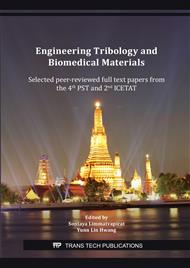[1]
E.d.S. Tolentino, B.S. Centurion, L.H.C. Ferreira, A.P.d. Souza, J.H. Damante, I.R.F. Rubira-Bullen, Oral adverse effects of head and neck radiotherapy: literature review and suggestion of a clinical oral care guideline for irradiated patients, J. Appl. Oral Sci. 19(5) (2011) 448-454.
DOI: 10.1590/s1678-77572011000500003
Google Scholar
[2]
S. Patil, R.S. Rao, B. Majumdar, S. Anil, Clinical appearance of oral Candida infection and therapeutic strategies, Front. Microbiol. 6 (1391) (2015).
DOI: 10.3389/fmicb.2015.01391
Google Scholar
[3]
A. Chatterjee, M. Saluja, G. Agarwal, M. Alam, Green tea: a boon for periodontal and general health, J. Indian Soc. Periodontol. 16(2) (2012) 161-167.
DOI: 10.4103/0972-124x.99256
Google Scholar
[4]
F. Wu, D. Bian, Y. Xia, Z. Gong, Q. Tan, J. Chen, Y. Dai, Identification of major active ingredients responsible for burn wound healing of Centella asiatica herbs, J. Evidence-Based Complementary Altern. Med. 2012 (2012) 1-13.
DOI: 10.1155/2012/848093
Google Scholar
[5]
C. Monton, S. Settharaksa, C. Luprasong, T. Songsak, An optimization approach of dynamic maceration of Centella asiatica to obtain the highest content of four centelloids by response surface methodology, Rev. Bras. Farmacogn. 29(2) (2019) 254-261.
DOI: 10.1016/j.bjp.2019.01.001
Google Scholar
[6]
W. Wisuitiprot, A. Somsiri, K. Ingkaninan, N. Waranuch, A novel technique for chitosan microparticle preparation using a water/silicone emulsion: green tea model, Int. J. Cosmet. Sci. 33(4) (2011) 351-358.
DOI: 10.1111/j.1468-2494.2010.00635.x
Google Scholar
[7]
W. Wisuitiprot, A. Somsiri, K. Ingkaninan, N. Waranuch, In vitro human skin permeation and cutaneous metabolism of catechins from green tea extract and green tea extract–loaded chitosan microparticles, Int. J. Cosmet. Sci. 33(6) (2011) 572-579.
DOI: 10.1111/j.1468-2494.2011.00673.x
Google Scholar
[8]
M.H. Rafamantanana, E. Rozet, G.E. Raoelison, K. Cheuk, S.U. Ratsimamanga, P. Hubert, J. Quetin-Leclercq, An improved HPLC-UV method for the simultaneous quantification of triterpenic glycosides and aglycones in leaves of Centella asiatica (L.) Urb (Apiaceae), J. Chromatogr. B: Anal. Technol. Biomed. Life Sci. 877(23) (2009) 2396-2402.
DOI: 10.1016/j.jchromb.2009.03.018
Google Scholar
[9]
Clinical and Laboratory Standards Institute, Method for antifungal disk diffusion susceptibility testing of yeasts, 3rd ed. M44. Clinical and Laboratory Standards Institute, Wayne, PA, (2018).
Google Scholar
[10]
Clinical and Laboratory Standards Institute, M11 Methods for antimicrobial susceptibility testing of anaerobic bacteria, 9th ed. M11. Clinical and Laboratory Standards Institute, Wayne, PA, (2018).
Google Scholar
[11]
E. Matuschek, D.F.J. Brown, G. Kahlmeter, Development of the EUCAST disk diffusion antimicrobial susceptibility testing method and its implementation in routine microbiology laboratories, Clin. Microbiol. Infect. 20(4) (2014) O255-O266.
DOI: 10.1111/1469-0691.12373
Google Scholar
[12]
A. Klančnik, S. Piskernik, B. Jeršek, S.S. Možina, Evaluation of diffusion and dilution methods to determine the antibacterial activity of plant extracts, J. Microbiol. Methods. 81(2) (2010) 121-126.
DOI: 10.1016/j.mimet.2010.02.004
Google Scholar
[13]
X. Xu, L. Xu, G. Yuan, Y. Wang, Y. Qu, M. Zhou, Synergistic combination of two antimicrobial agents closing each other's mutant selection windows to prevent antimicrobial resistance, Sci. Rep. 8(1) (2018).
DOI: 10.1038/s41598-018-25714-z
Google Scholar
[14]
M. Balouiri, M. Sadiki, S.K. Ibnsouda, Methods for in vitro evaluating antimicrobial activity: a review, J. Pharm. Anal. 6(2) (2016) 71-79.
DOI: 10.1016/j.jpha.2015.11.005
Google Scholar
[15]
J.C. Stockert, A. Blázquez-Castro, M. Cañete, R.W. Horobin, Á. Villanueva, MTT assay for cell viability: intracellular localization of the formazan product is in lipid droplets, Acta Histochem. 114(8) (2012) 785-796.
DOI: 10.1016/j.acthis.2012.01.006
Google Scholar
[16]
A. Grada, M. Otero-Vinas, F. Prieto-Castrillo, Z. Obagi, V. Falanga, Research techniques made simple: analysis of collective cell migration using the wound healing assay, J. Invest. Dermatol. 137(2) (2017) e11-e16.
DOI: 10.1016/j.jid.2016.11.020
Google Scholar
[17]
ICH, Q1A (R2) Stability testing of new drug substances and products, (2003).
Google Scholar
[18]
U. Markens, SGS, Conducting stability studies-recent changes to climatic zone IV, Life science, Technical bullet, 2009, pp.1-4.
Google Scholar
[19]
K.H. Row, Y. Jin, Recovery of catechin compounds from Korean tea by solvent extraction, Bioresour. Technol. 97(5) (2006) 790-793.
DOI: 10.1016/j.biortech.2005.04.001
Google Scholar
[20]
H. Barroso, R. Ramalhete, A. Domingues, S. Maci, Inhibitory activity of a green and black tea blend on Streptococcus mutans, J. Oral Microbiol. 10(1) (2018).
DOI: 10.1080/20002297.2018.1481322
Google Scholar
[21]
M. Chen, L. Zhai, M.C. Arendrup, In vitro activity of 23 tea extractions and epigallocatechin gallate against Candida species, Med. Mycol. 53(2) (2015) 194-198.
DOI: 10.1093/mmy/myu073
Google Scholar
[22]
W.C. Reygaert, Green tea catechins: their use in treating and preventing infectious diseases, BioMed Res. Int. 2018 (2018) 1-9.
DOI: 10.1155/2018/9105261
Google Scholar
[23]
P. Onklay, Development of antibacterial liquid soap containing assum tea extract, Naresuan University, Phitsanulok, (2009).
Google Scholar
[24]
I.A. Casalinuovo, R. Sorge, G. Bonelli, P. Di Francesco, Evaluation of the antifungal effect of EDTA, a metal chelator agent, on Candida albicans biofilm, Riv. Eur. Sci. Med. Farmacol. 21 (2017) 1413-1420.
Google Scholar


